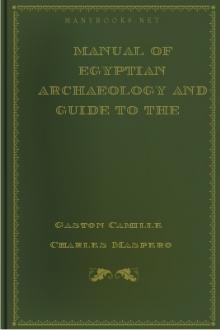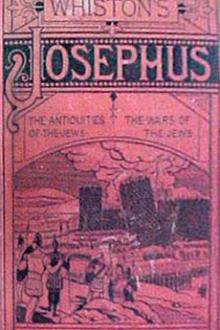Manual of Egyptian Archaeology and Guide to the Study of Antiquities in Egypt by Gaston Maspero (i have read the book txt) 📕

107. Wall-scene from temple of Denderah
108. Obelisk of Heliopolis, Twelfth Dynasty
109. Obelisk of Begig, Twelfth Dynasty
110. "Table of offerings" from Karnak
111. Limestone altar from Menshîyeh
112. Wooden naos, in Turin Museum
113. A mastaba
114. False door in mastaba
115. Plan of forecourt, mastaba of Kaäpir
116. Plan of forecourt, mastaba of Neferhotep
117. Door in mastaba façade
118. Portico and door of mastaba
119. Plan of chapel, mastaba of Khabiûsokari
120. Plan of chapel, mastaba of Ti
121. Plan of chapel, mastaba of Shepsesptah
122. Plan of chapel, mastaba of Affi
123. Plan of chapel, mastaba of Thenti
124. Plan of chapel, mastaba of Red Scribe
125. Plan of chapel, mastaba of Ptahhotep
126. Stela in mastaba of Merrûka
127. Wall-scene from mastaba of Ptahhotep
128. Wall-scene from mastaba of Ûrkhûû
129. Wall-scene from mastaba of Ptahhotep
130. Plan of serdab in mastaba at Gizeh
131. Plan of serdab and
Read free book «Manual of Egyptian Archaeology and Guide to the Study of Antiquities in Egypt by Gaston Maspero (i have read the book txt) 📕» - read online or download for free at americanlibrarybooks.com
- Author: Gaston Maspero
- Performer: -
Read book online «Manual of Egyptian Archaeology and Guide to the Study of Antiquities in Egypt by Gaston Maspero (i have read the book txt) 📕». Author - Gaston Maspero
It lacks the breadth and learning of the first Memphite school; it also lacks the grand, and sometimes rude, manner of the great Theban school. The proportions of the human body are reduced and elongated, and the limbs lose in vigour what they gain in elegance. A noteworthy change in the choice of attitudes will also be remarked. Orientals find repose in postures which would be inexpressibly fatiguing to ourselves. For hours together they will kneel; or sit tailor-wise, with the legs crossed and laid down flat to the ground; or squat, sitting upon their heels, with no other support than is afforded by that part of the sole of the foot which rests upon the ground; or they will sit upon the floor with their legs close together, and their arms crossed upon their knees. These four attitudes were customary among the people from the time of the ancient empire.
This we know from the bas-reliefs. But the Memphite sculptors, deeming the two last ungraceful, excluded them from the domain of art, and rarely, if ever, reproduced them. Fig 205.--Squatting statue of Pedishashi. Saïte work. Fig 205.--Squatting statue of Pedishashi. Saïte work.
The "Cross-legged Scribe" of the Louvre and the "Kneeling Scribe" of Gizeh show with what success they could employ the two first. The third was neglected (doubtless for the same reason) by the Theban sculptors. The fourth began to be currently adopted about the time of the Eighteenth Dynasty.
It may be that this position was not in fashion among the moneyed classes, which alone could afford to order statues; or it may be that the artists themselves objected to an attitude which caused their sitters to look like square parcels with a human head on the top. The sculptors of the Saïte period did not inherit that repugnance. They have at all events combined the action of the limbs in such wise as may least offend the eye, and the position almost ceases to be ungraceful. The heads also are modelled to such perfection that they make up for many shortcomings. That of Pedishashi (fig. 205) has an expression of youth and intelligent gentleness such as we seldom meet with from an Egyptian hand. Other heads, on the contrary, are remarkable for their almost brutal frankness of treatment. Fig 206.--Head of a scribe. Saïte work. Fig 206.--Head of a scribe. Saïte work.
In the small head of a scribe (fig. 206), lately purchased for the Louvre, and in another belonging to Prince Ibrahim at Cairo, the wrinkled brow, the crow's-feet at the corners of the eyes, the hard lines about the mouth, and the knobs upon the skull, are brought out with scrupulous fidelity. The Saïte school was, in fact, divided into two parties. One sought inspiration in the past, and, by a return to the methods of the old Memphite school, endeavoured to put fresh life into the effeminate style of the day. This it accomplished, and so successfully, that its works are sometimes mistaken for the best productions of the Fourth and Fifth Dynasties. The other, without too openly departing from established tradition, preferred to study from the life, and thus drew nearer to nature than in any previous age. This school would, perhaps, have prevailed, had Egyptian art not been directed into a new channel by the Macedonian conquest, and by centuries of intercourse with the Greeks.
The new departure was of slow development. Fig 207.--Colossus of Alexander II. Fig 207.--Colossus of Alexander II.
Sculptors began by clothing the successors of Alexander in Egyptian garb and transforming them into Pharaohs, just as they had in olden time transformed the Hyksos and the Persians. Works dating from the reigns of the first Ptolemies scarcely differ from those of the best Saïte period, and it is only here and there that we detect traces of Greek influence. Thus, the colossus of Alexander II., at Gizeh (fig. 207), wears a flowing head-dress, from beneath which his crisp curls have found their way. Soon, however, the sight of Greek masterpieces led the Egyptians of Alexandria, of Memphis, and of the cities of the Delta to modify their artistic methods. Then arose a mixed school, which combined certain elements of the national art with certain other elements borrowed from Hellenic art. The Alexandrian Isis of the Gizeh Museum is clad as the Isis of Pharaonic times; but she has lost the old slender shape and straitened bearing. A mutilated effigy of a Prince of Siût, also at Gizeh, would almost pass for an indifferent Greek statue.
The most forcible work of this hybrid class which has come down to us is the portrait-statue of one Hor (fig. 208), discovered in 1881 at the foot of Kom ed Damas, the site of the tomb of Alexander. The head is good, though in a somewhat dry style. The long, pinched nose, the close-set eyes, the small mouth with drawn-in corners, the square chin,--every feature, in short, contributes to give a hard and obstinate character to the face. The hair is closely cropped, yet not so closely as to prevent it from dividing naturally into thick, short curls. The body, clothed in the chlamys, is awkwardly shapen, and too narrow for the head. One arm hangs pendent; the other is brought round to the front; the feet are lost. Fig 208.--Statue of Hor, Graeco-Egyptian. Fig 208.--Statue of Hor, Graeco-Egyptian.
All these monuments are the results of few excavations; and I do not doubt that the soil of Alexandria would yield many such, if it could be methodically explored. The school which produced them continued to draw nearer and nearer to the schools of Greece, and the stiff manner, which it never wholly lost, was scarcely regarded as a defect at an epoch when certain sculptors in the service of Rome especially affected the archaic style. I should not be surprised if those statues of priests and priestesses wearing divine insignia, with which Hadrian adorned the Egyptian rooms of his villa at Tibur, might not be attributed to the artists of this hybrid school. In those parts which were remote from the Delta, native art, being left to its own resources, languished, and slowly perished. Nor was this because Greek models, or even Greek artists, were lacking. In the Thebaid, in the Fayûm, at Syene, I have both discovered and purchased statuettes and statues of Hellenic style, and of correct and careful execution. One of these, from Coptos, is apparently a miniature replica of a Venus analogous to the Venus of Milo. But the provincial sculptors were too dull, or too ignorant, to take such advantage of these models as was taken by their Alexandrian brethren. When they sought to render the Greek suppleness of figure and fulness of limb, they only succeeded in missing the rigid but learned precision of their former masters. In place of the fine, delicate, low relief of the old school, they adopted a relief which, though very prominent, was soft, round, and feebly modelled. The eyes of their personages have a foolish leer; the nostrils slant upwards; the corners of the mouth, the chin, and indeed all the features, are drawn up as if converging towards a central point, which is stationed in the middle of the ear. Two schools, each independent of the other, have bequeathed their works to us. The least known flourished in Ethiopia, at the court of the half-civilised kings who resided at Meroë. Fig 209.--Group from Naga. Fig 209.--Group from Naga.
A group brought from Naga in 1882, and now in the Gizeh collection, shows the work of this school during the first century of our era (fig. 209). A god and a queen, standing side by side, are roughly cut in a block of grey granite. The work is coarse and heavy, but not without energy. Isolated and lost in the midst of savage tribes, the school which produced it sank rapidly into barbarism, and expired towards the end of the age of the Antonines. The Egyptian school, sheltered by the power of Rome, survived a little longer. As sagacious as the Ptolemies, the Caesars knew that by flattering the religious prejudices of their Egyptian subjects they consolidated their own rule in the valley of the Nile. At an enormous cost, they restored and rebuilt the temples of the national gods, working after the old plans and in the old spirit of Pharaonic times. The great earthquake of B.C. 22 had destroyed Thebes, which now became a mere place of pilgrimage, whither devotees repaired to listen to the voice of Memnon at the rising of Aurora. But at Denderah and Ombos, Tiberius and Claudius finished the decoration of the great temples. Caligula worked at Coptos, and the Antonines enriched Esneh and Philae. The gangs of workmen employed in their names were still competent to cut thousands of bas-reliefs according to the rules of the olden time. Their work was feeble, ungraceful, absurd, inspired solely by routine; yet it was founded on antique tradition-- tradition enfeebled and degenerate, but still alive. The troubles which convulsed the third century of our era, the incursions of barbarians, the progress and triumph of Christianity, caused the suspension of the latest works and the dispersion of the last craftsmen. With them died all that yet survived of the national art.[54]
I have treated briefly of the Noble Arts; it remains to say something of the Industrial Arts. All classes of society in Egypt were, from an early period, imbued with the love of luxury, and with a taste for the beautiful. Living or dead, the Egyptian desired to have jewels and costly amulets upon his person, and to be surrounded by choice furniture and elegant utensils. The objects of his daily use must be distinguished, if not by richness of material, at least by grace of form; and in





Comments (0)